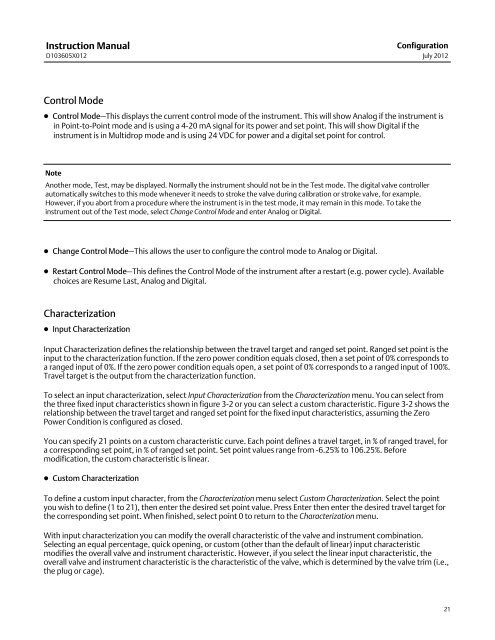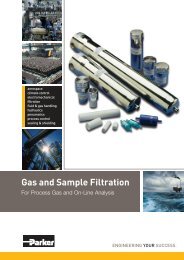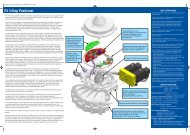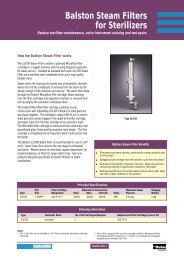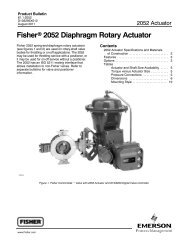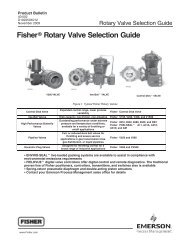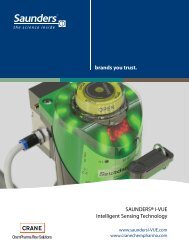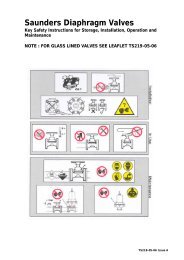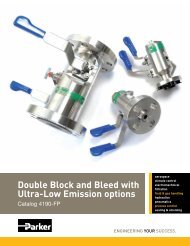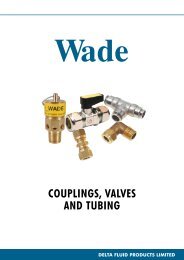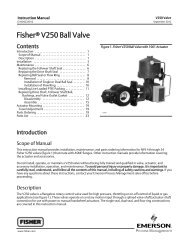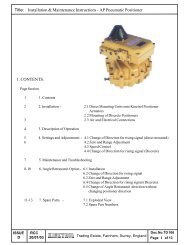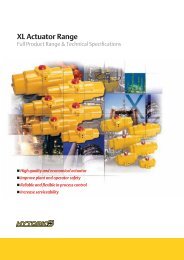Fisher® FIELDVUE DVC6200 Digital Valve Controller
Fisher® FIELDVUE DVC6200 Digital Valve Controller
Fisher® FIELDVUE DVC6200 Digital Valve Controller
You also want an ePaper? Increase the reach of your titles
YUMPU automatically turns print PDFs into web optimized ePapers that Google loves.
Instruction Manual<br />
D103605X012<br />
Configuration<br />
July 2012<br />
Control Mode<br />
Control Mode—This displays the current control mode of the instrument. This will show Analog if the instrument is<br />
in PointtoPoint mode and is using a 420 mA signal for its power and set point. This will show <strong>Digital</strong> if the<br />
instrument is in Multidrop mode and is using 24 VDC for power and a digital set point for control.<br />
Note<br />
Another mode, Test, may be displayed. Normally the instrument should not be in the Test mode. The digital valve controller<br />
automatically switches to this mode whenever it needs to stroke the valve during calibration or stroke valve, for example.<br />
However, if you abort from a procedure where the instrument is in the test mode, it may remain in this mode. To take the<br />
instrument out of the Test mode, select Change Control Mode and enter Analog or <strong>Digital</strong>.<br />
Change Control Mode—This allows the user to configure the control mode to Analog or <strong>Digital</strong>.<br />
Restart Control Mode—This defines the Control Mode of the instrument after a restart (e.g. power cycle). Available<br />
choices are Resume Last, Analog and <strong>Digital</strong>.<br />
Characterization<br />
Input Characterization<br />
Input Characterization defines the relationship between the travel target and ranged set point. Ranged set point is the<br />
input to the characterization function. If the zero power condition equals closed, then a set point of 0% corresponds to<br />
a ranged input of 0%. If the zero power condition equals open, a set point of 0% corresponds to a ranged input of 100%.<br />
Travel target is the output from the characterization function.<br />
To select an input characterization, select Input Characterization from the Characterization menu. You can select from<br />
the three fixed input characteristics shown in figure 3‐2 or you can select a custom characteristic. Figure 3‐2 shows the<br />
relationship between the travel target and ranged set point for the fixed input characteristics, assuming the Zero<br />
Power Condition is configured as closed.<br />
You can specify 21 points on a custom characteristic curve. Each point defines a travel target, in % of ranged travel, for<br />
a corresponding set point, in % of ranged set point. Set point values range from -6.25% to 106.25%. Before<br />
modification, the custom characteristic is linear.<br />
Custom Characterization<br />
To define a custom input character, from the Characterization menu select Custom Characterization. Select the point<br />
you wish to define (1 to 21), then enter the desired set point value. Press Enter then enter the desired travel target for<br />
the corresponding set point. When finished, select point 0 to return to the Characterization menu.<br />
With input characterization you can modify the overall characteristic of the valve and instrument combination.<br />
Selecting an equal percentage, quick opening, or custom (other than the default of linear) input characteristic<br />
modifies the overall valve and instrument characteristic. However, if you select the linear input characteristic, the<br />
overall valve and instrument characteristic is the characteristic of the valve, which is determined by the valve trim (i.e.,<br />
the plug or cage).<br />
21


